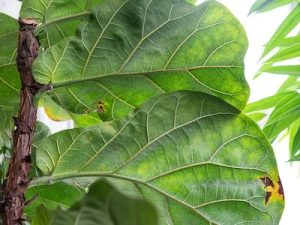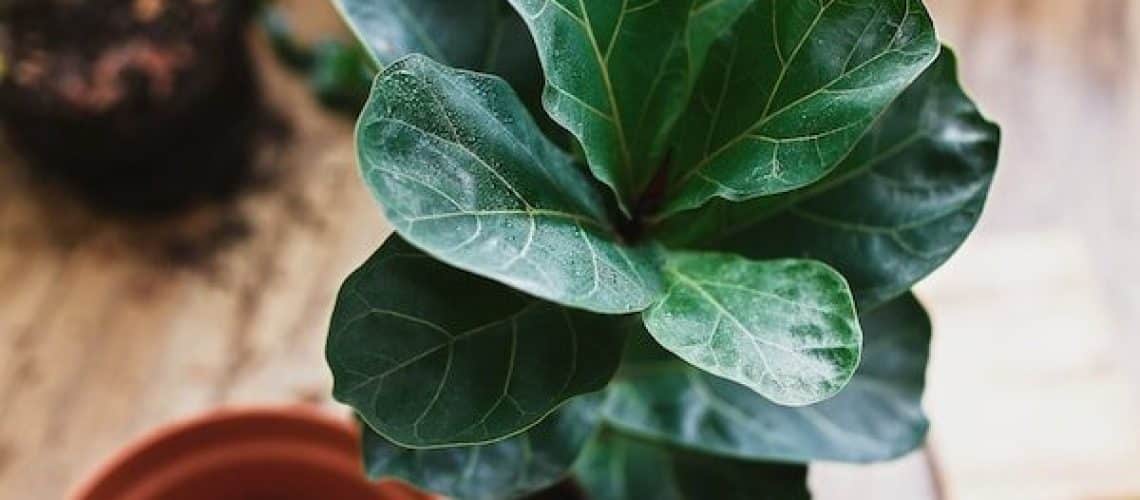What are fiddle leaf fig trees?
The fiddle leaf fig tree – also known as Ficus Lyrata – has become a staple in the portfolios of many interior designers and savvy home decor enthusiasts, and for good reason! This gorgeous house plant boasts large, lustrous, shiny leaves that adds a touch of sculptural luxury to any home. Able to grow up to 6 feet tall when planted in a pot, this plant really makes a statement when included in any decorating scheme, and looks great either paired with other foliage or just on its own.
Proving it isn’t just about looks, this plant’s broad leaves are known to be extremely effective when it comes to air purification too, which makes it wonderful for homes that are exposed to environmental pollution and allergens. Another benefit of this tropical plant is that it helps control humidity levels in a room, which makes it a lovely buddy for other tropical plants in a home.
The fiddle leaf fig tree is an evergreen plant that originally came from the lowland rainforests in the tropical regions of Central and West Africa. This is why this particular plant generally does best when grown in tropical and warm-temperate climates, although it can still survive in other climates with the right conditions.
While it is popular, this aesthetically pleasing plant has somewhat of a reputation as being rather difficult to keep alive and thriving, but all you need is a little bit of hard work and know-how to keep a fiddle leaf fig tree happy and healthy.
Caring for a fiddle leaf fig tree
The first thing to invest in when welcoming a fiddle leaf fig to your home is a premium potting mix. A moist, humus-rich soil with a PH of 6-7 is best. It’s also important that the soil is well aerated and fast draining, because this plant prefers a relatively dry soil to avoid drowning its roots. Soil that remains wet can lead to a host of problems, including the (unwanted) introduction of fungus or bacteria into its root system, and even root rot, which is the one thing that will kill any plant.
As mentioned before, this plant’s origins mean that it requires a lot of sunlight. In general, at least 6 hours of indirect sunlight is required to keep this plant happy when indoors. Positioning it near an eastern-facing window of your home is highly recommended. If you intend to place it outdoors, a partially shaded position is best.
The fiddle leaf fig tree requires frequent watering in spring and summer when it does most of its growing, but generally slows down growth almost completely and requires very little watering in colder weather. In general, the rule of thumb is to allow the soil to completely dry out between each watering, regardless of the climate. Over-watering is one of the main killers of this plant, so it’s best to err on the side of under-watering until you get the watering schedule just right!
Love Fiddle Leaf Figs? Discover Stunning Maintenance-Free Alternatives!
During high growth periods, you can support your plant’s growth by feeding it with a controlled-release fertiliser at the beginning of spring, followed by water soluble fertiliser every month up until autumn.
An additional requirement for this finicky plant is limited movement of air. So avoid placing it anywhere with drafts, like air conditioners or heaters. Also, in spite of its name, this plant doesn’t enjoy being fiddled with too much – avoid touching it often, and definitely avoid moving it around too much.
To make sure fiddle leaf plants grow at a steady rate, it needs a re-potting every couple of years or so. To do this, make sure to prepare a slightly bigger pot or planter that has good drainage. Fill this pot with approximately 4 inches of potting mix before carefully removing the plant from its old pot and placing it into its new pot. After that, just make sure to fill the sides of the pot with more soil, and you’re all done!
To recap, the fiddle leaf fig needs sun, but not too much or too little. It also needs water, but not too little and never too much. It also needs to be left alone most of the time, unless you are gently wiping its leaves to remove dust buildup.
While it is clear that the fiddle leaf fig tree is gorgeous to behold, but it isn’t the easiest plant to manage! So although these tips will help you on your way to having a happy and healthy fiddle leaf fig, bear in mind that your approach to its care might need tweaking until it is perfected.
Common problems with fiddle leaf figs

As mentioned previously, the most common problem with fiddle leaf figs is over-watering. You can usually spot signs of over-watering by observing the leaves – yellowing or droopy leaves are a sure sign that your plant is getting far too much moisture in its roots. To avoid root rot and infection, it is vital to resolve this issue as soon as you notice it. Move the plant to sunnier spot and reduce the frequency of watering until your plant is healthy again.
The large leaves of this plant are a useful way of discerning the issues it may be facing. Brown spots usually mean that the air is too dry or it’s been handled too much. One quick way to resolve the issue of air dryness is to mist your fiddle leaf fig leaves every other week. As for being handled too much? Make sure the plant is in a low-traffic area and away from curious hands (including yours!).
White spots on the leaves of the fiddle leaf fig is a sign that the water you’re using may be too hard. The white spots are essentially mineral residue from the water, and require removal to restore the vibrant shine of the leaves. Start by spraying a combination of purified or distilled water and a little bit of detergent-free soap like castile soap onto the leaves, then gently wipe away the hard water spots with a microfiber cloth. Finish off the clean-up by thoroughly rinsing the plant with water.
If you have droopy leaves, just know that it could be a sign of several issues. The most common cause is shock, which usually happens when a fiddle leaf fig tree has been moved. It could also be either over-watered, or dehydrated. Consider your watering schedule and adjusting accordingly, remembering to always let the soil dry out completely between waterings.
Is the fiddle leaf fig right for you?
The fiddle leaf fig looks wonderful in any home, but there are some situations where it may not be the most appropriate plant to own.
For instance, it’s important to note that this plant is poisonous for pets and children. The leaves contain crystals made from toxic calcium oxalate. This won’t have much of an effect on an adult, but can prove fatal with animals and small children. So if your household includes curious tikes and furry friends, this is not the best plant to have in your home.
This plant also has very specific light and humidity requirements. If you do not have a well-lit home or, at the very least, an eastern-facing window with ample sunlight, it may be nearly impossible for you to keep this plant alive and healthy.
You should also consider this plant’s ample size when considering it for your space. It grows rapidly – sometimes up to a whole meter every year! While this seems appealing when you’ve got a tiny fiddle leaf fig, it becomes a little bit of an issue when it begins to outgrow your home.















